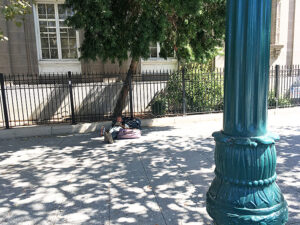By Jondi Gumz
Since 2019, Santa Cruz County made progress in finding homes for unsheltered families and young people age 18-24, but the number of homeless veterans and chronically homeless people with mental illness or drug addiction more than doubled, resulting in an 6% increase overall, from 2,167 to 2,299, according to the 2022 Point-In-Time Count.
Data:
- 128% increase in chronically homeless people with mental illness or drug addiction, from 403 to 921
- 120% increase in homeless veterans, from 151 to 332
- 59% decrease in homeless families – only five unsheltered
- 61% decrease in homeless young people age 18-24
- 1,073 people report substance use
- 818 people report serious mental illness
Santa Cruz County Board of Supervisors got a summary of the findings Tuesday from Robert Ratner, director of the County of Santa Cruz Housing for Health Division, and Randy Morris, director of the county Human Services Department.

A man without a home finds a spot to rest by the Post Office in Santa Cruz. • Photo Credit: Jondi Gumz
Applied Survey Research of Watsonville, which carried out the homeless count, will have a complete report in a couple months.
Morris said 322 people were served with 145 moving into permanent homes. Another 441 households have rental vouchers from the housing authority, with 167 finding a place and the rest still looking.
“The biggest challenge is available rental units in a tight market,” Morris said. “We’re looking at options outside Santa Cruz County.”
He cited a recent report that found a wage of $60.35 an hour — up from $58.10 in 2021 — is needed to afford a two-bedroom apartment.
“You need four full-time jobs, two people working two full-time jobs,” Morris said. “A lot of our staff can’t afford to live here.”
Asked why more veterans were homeless, Ratner was not sure.
“We need to do a little more research,” he said, noting 40 to 50 have rental vouchers but haven’t found a local landlord willing to accept that payment.
One factor may be the loss of 900 homes in San Lorenzo Valley and Bonny Doon during the 2020 CZU fire.
Federal disability payments, currently $841 per month, do not cover rental costs.
Despite the need, little affordable housing is being built, with 153 of 734 building permits targeting very-low-income housing — 21%.
Health issues are another factor.
“People with really significant health issues need a lot of support to get back into housing,” Ratner said, referring to people with disabilities.
“It’s really challenging to help them locate to another community without knowing if the supports are there…Families and youth have a little more mobility.”
Ratner added, “We talk about this with staff. Having more realistic conversations analyzing the pros and cons of staying in current situations vs. taking a unit in another community. I think folks are doing more and more of that.”
Does that mean you’re not going to try to build affordable housing?
No, Ratner said, it’s not either-or.
Yet he is loath to have people suffer “while we’re waiting for years — because these projects take years.”
Morris noted the downside of people relocating to get an affordable place to live.
“For some, this is their community,” he said. “They lose all their connections.”
About half self-report substance abuse and three-quarters report a disabling condition.
“We will work more closely with behavioral health to address that,” Morris said.
Supervisor Ryan Coonerty contends meth addiction is driving the crisis.
“Even if we get a lot of dollars and build a lot of housing and take on a lot of neighborhoods, we can at best may be able to house one out of 10, maybe one out of every eight who are experiencing homelessness in this county, he said. “That leaves a lot of people on a list to nowhere … it’s not about putting people on buses and getting them out of our community. It’s about finding places where work and housing balance is more in line and they will have more opportunity to be supported. Support when they get there is key … Otherwise we are fighting an uphill battle.”
Santa Cruz County applied to the state for $53.5 million in Homekey funds to create 155 affordable units.
So far, the county got $17 million toward 56 units.
One is the Vets Village in Ben Lomond , $6,425,000 for 20 units at the former Jay’s Timberlane Resort.
The other is the future Park Haven Plaza, 2838 Park Ave., Soquel, $10,660,000 for 36 units for young people 18-24, families and veterans.
A decision is pending on 801 River St., Santa Cruz, 7 units, up to $4 million requested for Housing Matters.
A request for up to $39 million to convert a 95-room Rodeway Inn,1620 Beach St., Watsonville, into permanent supportive micro-units was denied, and is being appealed.
For the future, Morris said the county will partner with Central California Alliance for Health; relaunch Home Safe for seniors and people with disabilities to retain or secure housing; and reach out to homeless people camping in San Lorenzo Park in Santa Cruz.
The county currently has 387 shelter beds; the target is 600.
Morris estimated $8 million to $12 million in operational funds are needed to reach that capacity, and said federal or state funds would be essential.
A recent report by the National Low Income Housing Coalition ranks Santa Cruz County as the second most expensive rental market in the country and the least affordable for local renters.
Comparisons:
- San Francisco (down 3.5%)
- Santa Clara County (up 3%)
- Alameda County (up 22%),
- Contra Costa County (up 35%)
- Monterey County (down 15.5%)
- San Benito County (up 21%)
When available, the full Point-in-Time Count report will be posted at https://housingforhealthpartnership.org/
The Housing for Health Partnership is a collaboration of the County and each city within Santa Cruz County, along with local homelessness service providers.
The County of Santa Cruz is the lead agency for the Partnership.